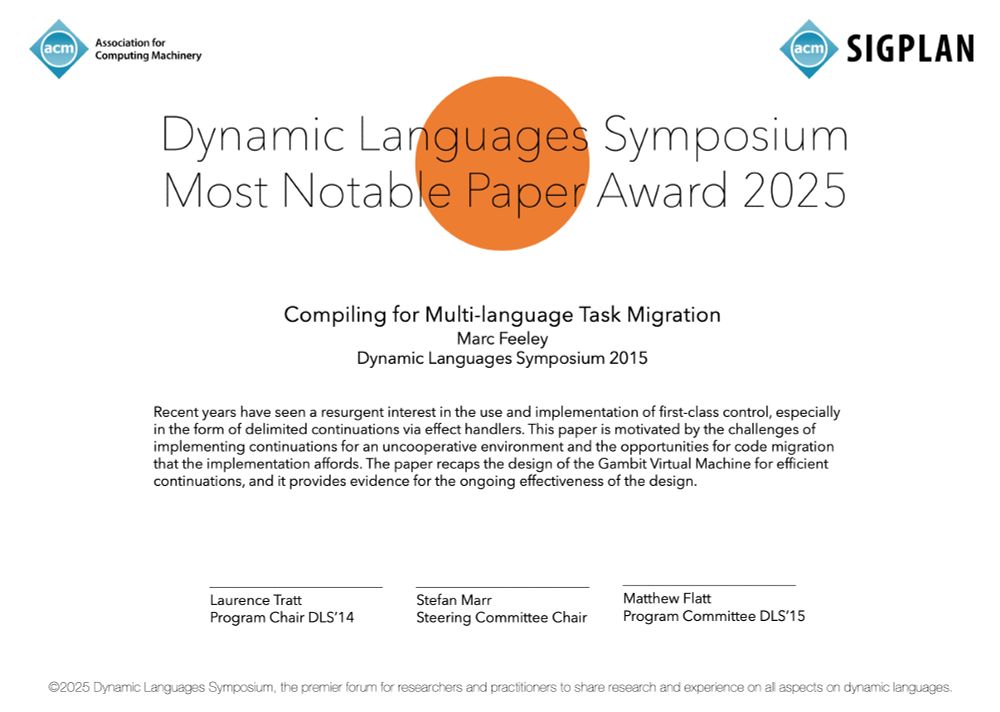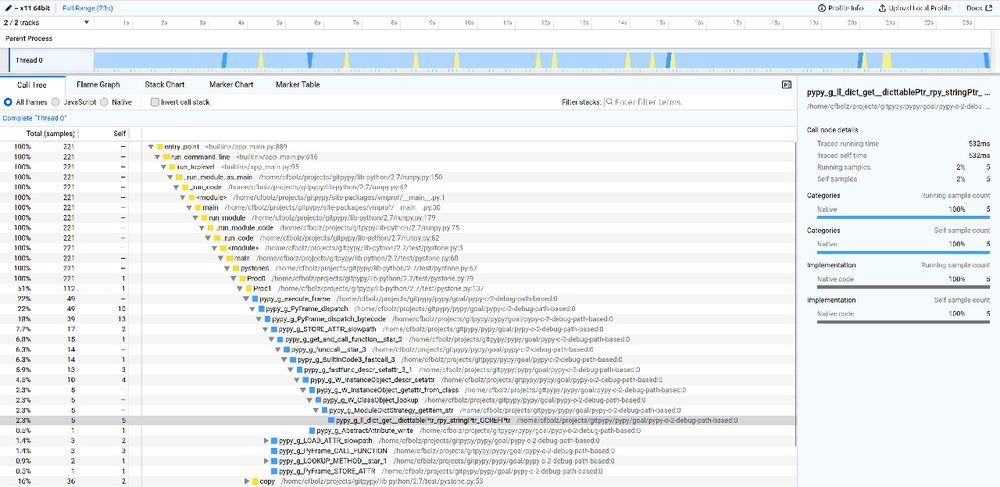
The award with the following citation:
Recent years have seen a resurgent interest in the use and implementation of first-class control, especially in the form of delimited continuations via effect handlers. This paper is motivated by the challenges of implementing continuations for an uncooperative environment and the opportunities for code migration that the implementation affords. The paper recaps the design of the Gambit Virtual Machine for efficient continuations, and it provides evidence for the ongoing effectiveness of the design.
This year's DLS Most Notable Paper award goes to
Compiling for Multi-language Task Migration
by Marc Feeley
The paper is motivated by the challenges of implementing continuations for an uncooperative environment, and worth a read!
Congratulations to the author! www.iro.umontreal.ca/~feeley/pape...
09.06.2025 16:34 — 👍 12 🔁 5 💬 0 📌 0
Adding heap operations to Z3 didn't actually find any bugs in the JIT optimizer for heap operations. Maybe that's not entirely surprising, because miscompilations in that area tend to lead to crashes pretty quickly. In any case, it's good to have that infrastructure for the future.
21.05.2025 08:16 — 👍 1 🔁 0 💬 0 📌 0
We also added limited support for generating random heap operations to our JIT optimizer fuzzer. This extends previous work, which supported only int operations in Z3:
pypy.org/posts/2022/1...
21.05.2025 08:16 — 👍 0 🔁 0 💬 1 📌 0
Christoph Jung, another student @cfbolz.bsky.social, added a memory model to our Z3 based translation validation. Now our CI checks whether our optimizer unit tests contain invalid optimizations using Z3.
21.05.2025 08:16 — 👍 0 🔁 0 💬 1 📌 0
Micro-benchmarks for both optimizations look great, but both are hard to see in the performance of bigger programs.
21.05.2025 08:16 — 👍 0 🔁 0 💬 1 📌 0
An unrelated optimization we also merged was to make store-to-load and load-to-load forwarding work for array reads and writes where the index is a variable. This already worked for constant indexes before.
21.05.2025 08:16 — 👍 1 🔁 0 💬 1 📌 0
We've already had type based alias analysis before, but only taking the RPython level types into account. Unfortunately instances of different Python classes get represented as instances of the same RPython type, making the old JIT logic useless for distinguishing them, which is now fixed.
21.05.2025 08:16 — 👍 0 🔁 0 💬 1 📌 0
We just merged an improvement to the PyPy JIT heap optimizations: type based alias analysis for Python instances. Work was done by @cfbolz.bsky.social and their student Nico Rittinghaus.
21.05.2025 08:16 — 👍 6 🔁 2 💬 1 📌 0
PyPy v7.3.19: release of python 2.7, 3.10 and 3.11 beta, released 2025-02-26 — PyPy documentation
Fast on the heels of the last release, I have published a PyPy v7.3.19 bug-fix release with PyPy2.7, PyPY3.10 and a beta-quality PyPy3.11. Please try it out! The complete release note is at doc.pypy.org/en/latest/re...
26.02.2025 12:26 — 👍 4 🔁 5 💬 0 📌 0
New blog post by my excellent master student Christoph Jung:
"Low Overhead Allocation Sampling with VMProf in PyPy's GC"
pypy.org/posts/2025/0...
Hopefully the first in a series about his work on a sampling allocation profiler for PyPy
25.02.2025 13:09 — 👍 8 🔁 3 💬 0 📌 0
Since I was now wondering, here's PyPy VS CPython 3.x binary sizes
13.02.2025 20:55 — 👍 2 🔁 1 💬 0 📌 0
Interestingly enough PyPy 3.x is mostly smaller than 2.7. E.g. PyPy 3.11 is 58.8 MiB, despite having a bunch more features. I never quite figure out why. Just for comparison, CPython 3.11 is 25.2 MiB.
13.02.2025 20:04 — 👍 2 🔁 1 💬 0 📌 0
This is the size of PyPy 2.7, btw. It doesn't make sense to use the 3.x variant for this, because the size of that changes due to newer Python versions being implemented over time.
13.02.2025 20:04 — 👍 0 🔁 1 💬 1 📌 0

plot showing how the PyPy binary went from 68 MiB in early 2020 to 61 MiB today, with a few ups and downs in between. various points in time are annotated with reasons for growth and shrinkage. the biggest shrinkage is: 2022-05-10 compact jitcode liveness info
We don't do this regularly or anything, but every couple of years @cfbolz.bsky.social looks at how the PyPy binary sizes have developed. Looks like an ok balance between occasionally cleaning something up and thereby shrinking the binary; and then slow growth or explicit time/binary-size-tradeoffs.
13.02.2025 20:04 — 👍 1 🔁 1 💬 1 📌 1
As a response to these benchmarks, @cfbolz.bsky.social optimized `itertools.islice` for the common case where no step is given, and also for converting large but not very large integers to strings (basically any int that doesn't fit into 64 bits, but is also not really huge, maybe a few words).
09.02.2025 16:54 — 👍 4 🔁 2 💬 0 📌 0

GitHub - ryanpetrello/sdb: a socket-based remote debugger for Python
a socket-based remote debugger for Python. Contribute to ryanpetrello/sdb development by creating an account on GitHub.
So far this is a rather low-level mechanism, there's no convenient pdb integration yet. We plan to add something like that later, for now you can use a third-party package such as sdb to get an actual remote debugger going: github.com/ryanpetrello...
07.02.2025 07:53 — 👍 0 🔁 0 💬 1 📌 0
Remote Debugging — PyPy documentation
The other new feature an implementation of the draft PEP 768, "Safe external debugger interface" (again, Linux only so far). PEP was written by @pablogsal.com et al. It allows you to remotely attach to a running PyPy process and inject Python code into it.
doc.pypy.org/en/latest/re...
07.02.2025 07:53 — 👍 0 🔁 1 💬 1 📌 0
We have further features planned for VMProf, including a stochastic memory profiler hopefully coming out later this year.
07.02.2025 07:47 — 👍 0 🔁 0 💬 1 📌 0

A screenshot of the Firefox profiler UI. It shows a hierarchically expandable view of stack traces together with counts of which stack traces were seen how often during sampling. The top layers of a stack trace are always yellow Python functions. the bottom layers show the native functions that these Python functions call in blue. One of the functions is selected, with extra information shown in a pane on the right.
Here's a screenshot of the Firefox Profiler UI showing VMProf output. The blue functions are native functions, yellow is Python functions and orange jitted functions (no example of that is in the screenshot).
07.02.2025 07:47 — 👍 2 🔁 3 💬 1 📌 0
VMProf on PyPy can now sample native functions and symbolify their names (Linux only at the moment). VMProf for CPython has had that feature for a while, we've now ported it to PyPy.
07.02.2025 07:47 — 👍 1 🔁 0 💬 1 📌 0
PyPy v7.3.18 release
PyPy v7.3.18: release of python 2.7, 3.10 and 3.11 beta
The PyPy team is proud to release version 7.3.18 of PyPy.
This release includes a python 3.11 interpreter. We are labelling it "beta"
because it
Here's the blog post about the PyPY 7.3.18 release that came out yesterday. Thanks to @matti-p.bsky.social, our release manager! This the first version with 3.11 support (beta only so far).
Two cool other features in the thread below.
pypy.org/posts/2025/0...
07.02.2025 07:47 — 👍 10 🔁 6 💬 1 📌 0
Hello, World!
06.02.2025 11:07 — 👍 18 🔁 5 💬 1 📌 0
Shopify / Royal Academy of Engineering Research Chair in Language Engineering. https://tratt.net/laurie/
SPy creator, HPy founder, PyPy core dev, PyScript core dev, doing Python, compilers and WASM stuff at @anacondainc.bsky.social
Also on:
- github.com/antocuni
- https://mastodon.social/@antocuni
- https://twitter.com/antocuni
Maintain Python upstream (http://python.org) and downstream (RHEL and Fedora) for Red Hat. Python core developer.
Payments Tech. @PyConUK Treasurer. @UKPython Trustee. Pythonista Arsonist. Tweets barely represent me, let alone anyone else. 2E0KGG. He/him.
Research Manager on the @graalvm.org team at Oracle Labs. Graal Languages, Native Image, developer tools, GraalVM developer experience. Previously at Hasso Plattner Institute, Google Colab, and Maton Guitars. Views are my own.
Quantum computing -- Lead R&D scientist at Quantinuum.
Researcher, Senior Lecturer. Working on interpreters, compilation, concurrency, and debugging tools.
Python, Boston, mathy fun, juggling, autism parenting. https://nedbat.com
Head of Algorithms Group at University of Marburg
www.wild-inter.net
Baking bread and compilers are kinda similar if you think about it
@tekknolagi elsewhere
bernsteinbear.com
PyPy/RPython contributor. Half time teaching at Uni Düsseldorf. Works on dynamic language implementations. Love street art and art in public spaces, hiking, reading.
they/them
official Bluesky account (check username👆)
Bugs, feature requests, feedback: support@bsky.app





